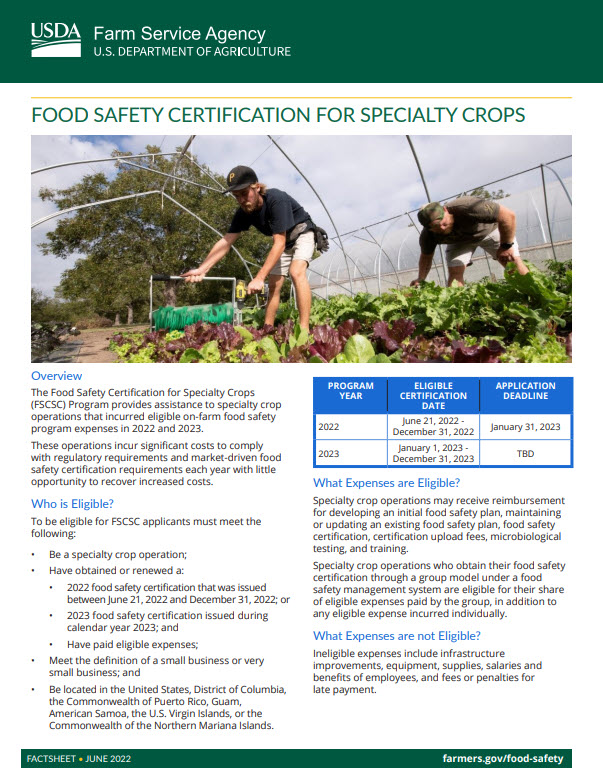- All travel time
- Preparation time to review food safety plans
- Time of on-site audit
- Administrative time to review, certify and post audit results
A typical GAP audit averages $900 – $1600, although it could possibly fall outside of this range. The cost of an audit is variable depending on the size of the operation, the diversity of crops and processes being audited, and the distance the auditor needs to travel. These costs could be reduced by coordinating the audits – having multiple growers in the same area ready for audits on the same day, which reduces the auditor travel time for each individual grower.
Any subsequent visits for unannounced or follow-up audits are charged on the same hourly basis. A typical unannounced audit costs $275 – $575.
The Harmonized GAP Plus+ service also requires payment of an annual $250 fee to maintain the GFSI certification.
Audit Fees for GroupGAP certification are harder to quantify. The table below lists the associated USDA audit activities and fees at the current rate of $132/hour.
On-site producer farm audits are performed by the USDA on a representative sample of farms, specifically on the square root of the number of group members. For example, based on a group size of 36 growers, 6 members’ farms will have on-site audits. The USDA also performs a system audit on the group, which looks at the implementation and adherence to the group’s QMS, including a review of all the internal audit records. This audit is charged at the current rate for the time to prepare the audit checklist, the auditor travel time, the time on-site, and the time to write the audit report.
Seeking certification through the GroupGAP program has been promoted as cost saving when compared to seeking certification as an individual grower because group members pool resources and share costs of the audit requirements. GroupGAP requires several initial investments – the USDA Application Fee ($1,056), the internal auditor training ($900), and group member QMS training (variable). Most fees are up-front, one-time expenses, reducing the expense of certification in subsequent years. The table below identifies the variability of calculating specific costs. Group size, use of consultants, travel time between member farms, and QMS complexity are just several factors that influence group expenses.
| Activity | Number of Hours | Fees |
|---|---|---|
| Initial Application Review and Fee | 8 | $1,056 (one-time fee) |
| USDA External Producer Audits
USDA System Audits USDA Follow-up Audits |
Actual audit time, including associated desk and on-site audit activity, and auditor travel time | $132/hour (variable) |
| Continued Participation Fee | 2 | $264 |
| Group Member List Change Fee (if needed) | 1 | $132 |
| Activity | Cost | Description |
|---|---|---|
| Auditor Training | $900, plus travel costs | One-time fee per internal auditor. Currently held virtually. |
| QMS Writing | 40 – 80 hours of staff time
$10,000 – $20,000 for consultant |
Resources are available for QMS writing, but groups may choose to use a consultant. |
| QMS Management | 40 – 400 hours of staff time | Will depend on the size of the group, complexity of the QMS, and other factors. |
| Internal audits (farm and QMS) | 1 – 6 hours of staff time per farm | Groups who choose to train internal group staff to perform internal audits will only incur travel costs and staff time. Other groups may choose to use a consultant to perform this function. |
There is no minimum number of farms required to pursue GroupGAP. However, there may be a break-even or minimum number of group members for GroupGAP participation to be cost effective. Cost savings will depend on the size of the group, size of the farms, distance between farms, as well as other variable factors. The more opportunities to share costs among a group lowers the cost for the individual grower.
While GroupGAP may not work for every grower, there are many grower communities who would benefit from participation, including growers who have access to shared-use land, growers in close proximity or communities with shared cultural beliefs.
Federal programs and grants that support GAP activities may also be available in some states. The new Food Safety Certification for Specialty Crops (FSCSC) Program provides assistance to specialty crop growers who incur eligible on-farm food safety program expenses in 2022 and 2023. The Farm Service Agency (FSA) will oversee the program and issue reimbursements. For more information, view the FSCSC FactSheet or contact your local FSA county office.
Another federal program is the USDA Risk Management Agency (RMA) Harmonized GAP Assistance Program that is available in select states.
Additional Costs
Many buyers and retailers require liability insurance, which is unrelated to GAP but is another expense growers may have to consider. The RMA is a great source of assistance and has introduced a new insurance policy for small farmers who sell locally; see press release below for more information. Additionally, the RMA revised the plan of Whole-Farm Revenue Protection (WFRP) insurance to make it more flexible and accessible to producers beginning in crop year 2022.
Please visit our Resource page for additional information, guides and checklists that can assist in the process.
In many cases, states offer cost-share programs, providing financial assistance for small farmers.



